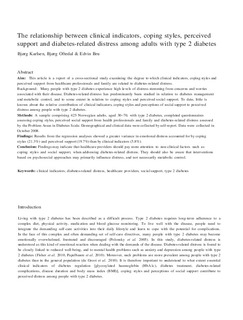| dc.contributor.author | Karlsen, Bjørg | |
| dc.contributor.author | Oftedal, Bjørg | |
| dc.contributor.author | Bru, Edvin | |
| dc.date.accessioned | 2013-07-29T09:24:23Z | |
| dc.date.available | 2013-07-29T09:24:23Z | |
| dc.date.issued | 2012 | |
| dc.identifier.citation | Karlsen, B., Oftedal, B., & Bru, E. (2012). The relationship between clinical indicators, coping styles, perceived support and diabetes‐related distress among adults with type 2 diabetes. Journal of Advanced Nursing, 68(2), 391-401. | no_NO |
| dc.identifier.uri | http://hdl.handle.net/11250/184076 | |
| dc.description | This is the pre-peer reviewed version of the following article: Karlsen, B., Oftedal, B., & Bru, E. (2012). The relationship between clinical indicators, coping styles, perceived support and diabetes‐related distress among adults with type 2 diabetes. Journal of Advanced Nursing, 68(2), 391-401., which has been published in final form at: DOI:10.1111/j.1365-2648.2011.05751.x. | no_NO |
| dc.description.abstract | Aim: This article is a report of a cross-sectional study examining the degree to which clinical indicators, coping styles and
perceived support from healthcare professionals and family are related to diabetes-related distress.
Background: Many people with type 2 diabetes experience high levels of distress stemming from concerns and worries
associated with their disease. Diabetes-related distress has predominantly been studied in relation to diabetes management
and metabolic control, and to some extent in relation to coping styles and perceived social support. To date, little is
known about the relative contribution of clinical indicators, coping styles and perceptions of social support to perceived
distress among people with type 2 diabetes.
Methods: A sample comprising 425 Norwegian adults, aged 30–70, with type 2 diabetes, completed questionnaires
assessing coping styles, perceived social support from health professionals and family and diabetes-related distress assessed
by the Problem Areas in Diabetes Scale. Demographical and clinical data were collected by self-report. Data were collected in
October 2008.
Findings: Results from the regression analyses showed a greater variance in emotional distress accounted for by coping
styles (21.3%) and perceived support (19.7%) than by clinical indicators (5.8%).
Conclusion: Findings may indicate that healthcare providers should pay more attention to non-clinical factors such as
coping styles and social support, when addressing diabetes-related distress. They should also be aware that interventions
based on psychosocial approaches may primarily influence distress, and not necessarily metabolic control. | no_NO |
| dc.language.iso | eng | no_NO |
| dc.publisher | John Wiley and Sons | no_NO |
| dc.subject | diabetes | no_NO |
| dc.subject | clinical indicators | no_NO |
| dc.subject | diabetes-related distress | no_NO |
| dc.subject | type 2 diabetes | no_NO |
| dc.subject | healthcare providers | no_NO |
| dc.subject | social support | no_NO |
| dc.title | The relationship between clinical indicators, coping styles, perceived support and diabetes-related distress among adults with type 2 diabetes | no_NO |
| dc.type | Journal article | no_NO |
| dc.subject.nsi | VDP::Medical disciplines: 700::Health sciences: 800 | no_NO |
| dc.source.pagenumber | 391-401 | no_NO |
| dc.source.volume | 68 | no_NO |
| dc.source.journal | Journal of Advanced Nursing | no_NO |
| dc.source.issue | 2 | no_NO |
| dc.identifier.doi | 10.1111/j.1365-2648.2011.05751.x | |
